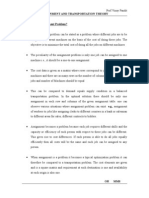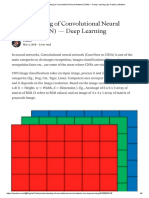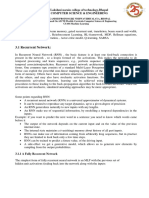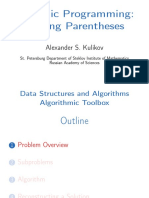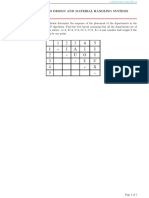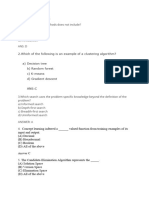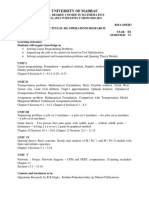100%(3)100% found this document useful (3 votes)
652 viewsCNN RNN LSTM GRU Simple
CNN RNN LSTM GRU Simple
Uploaded by
bhavanaThe document provides an overview of different neural network architectures including Convolutional Neural Networks (CNNs), Recurrent Neural Networks (RNNs), and Long Short-Term Memory (LSTM) networks. It describes the basic components and functions of a CNN including convolution, pooling, and fully connected layers. It then explains the need for RNNs and LSTMs to process sequential data and address issues like vanishing gradients. Key aspects of RNNs, LSTMs, and Gated Recurrent Units (GRUs) like their structures, gates, memory cells, and differences are defined. Diagrams are included to illustrate how information flows through these different neural network types.
Copyright:
© All Rights Reserved
Available Formats
Download as PPT, PDF, TXT or read online from Scribd
CNN RNN LSTM GRU Simple
CNN RNN LSTM GRU Simple
Uploaded by
bhavana100%(3)100% found this document useful (3 votes)
652 views20 pagesThe document provides an overview of different neural network architectures including Convolutional Neural Networks (CNNs), Recurrent Neural Networks (RNNs), and Long Short-Term Memory (LSTM) networks. It describes the basic components and functions of a CNN including convolution, pooling, and fully connected layers. It then explains the need for RNNs and LSTMs to process sequential data and address issues like vanishing gradients. Key aspects of RNNs, LSTMs, and Gated Recurrent Units (GRUs) like their structures, gates, memory cells, and differences are defined. Diagrams are included to illustrate how information flows through these different neural network types.
Original Description:
CNN RNN LSTM GRU
Original Title
CNN RNN LSTM GRU simple ppt
Copyright
© © All Rights Reserved
Available Formats
PPT, PDF, TXT or read online from Scribd
Share this document
Did you find this document useful?
Is this content inappropriate?
The document provides an overview of different neural network architectures including Convolutional Neural Networks (CNNs), Recurrent Neural Networks (RNNs), and Long Short-Term Memory (LSTM) networks. It describes the basic components and functions of a CNN including convolution, pooling, and fully connected layers. It then explains the need for RNNs and LSTMs to process sequential data and address issues like vanishing gradients. Key aspects of RNNs, LSTMs, and Gated Recurrent Units (GRUs) like their structures, gates, memory cells, and differences are defined. Diagrams are included to illustrate how information flows through these different neural network types.
Copyright:
© All Rights Reserved
Available Formats
Download as PPT, PDF, TXT or read online from Scribd
Download as ppt, pdf, or txt
100%(3)100% found this document useful (3 votes)
652 views20 pagesCNN RNN LSTM GRU Simple
CNN RNN LSTM GRU Simple
Uploaded by
bhavanaThe document provides an overview of different neural network architectures including Convolutional Neural Networks (CNNs), Recurrent Neural Networks (RNNs), and Long Short-Term Memory (LSTM) networks. It describes the basic components and functions of a CNN including convolution, pooling, and fully connected layers. It then explains the need for RNNs and LSTMs to process sequential data and address issues like vanishing gradients. Key aspects of RNNs, LSTMs, and Gated Recurrent Units (GRUs) like their structures, gates, memory cells, and differences are defined. Diagrams are included to illustrate how information flows through these different neural network types.
Copyright:
© All Rights Reserved
Available Formats
Download as PPT, PDF, TXT or read online from Scribd
Download as ppt, pdf, or txt
You are on page 1of 20
Architecture of Simple CNN ( Convolutional
Neural Network)
Fig: Simple CNN model
Convolution layer
To extract the features from the inputs convolution layer is
used. These feature maps are produced by the multiplication
of input data with so many filters . The example of the
convolution process is shown in the below figure.
Fig : Convolution operation of n×1 matrix with 3×1 filter
Pooling layer
The purpose of the pooling layer is to reduce the size of
convolved features. By considering only the dominant
information, the computation power needed to process the data
is also reduced. Generally used pooling techniques are Max
pooling and average pooling. Max pooling gives the maximum
value and the Average pooling gives the average value from
the selected portions.
Fig : 1D max pool operation
Fully Connected layer
Fully connected layer have full connections to all
activations in the previous layer.
Fully connected layers are the normal flat feed-forward
neural network layers. After the pooling layers, pixels of
pooling layers is stretched to single column vector. These
vectorized and concatenated data points are fed into dense
layers ,known as fully connected layers for the
classification.
Recurrent Neural Networks
Recurrent neural network (RNN) is a neural network model
proposed in the 80’s for modelling time series
Recurrent neural networks were created because there were a
few issues in the feed-forward neural network:
Cannot handle sequential data
Considers only the current input
Cannot memorize previous inputs
The solution to these issues is the Recurrent Neural Network
(RNN). An RNN can handle sequential data, accepting the
current input data, and previously received inputs. RNNs can
memorize previous inputs due to their internal memory.
Structure of RNN
• The structure of the network is similar to feedforward neural network,
with the distinction that it allows a recurrent hidden state whose
activation at each time is dependent on that of the previous time (cycle).
Fig: Recurrent Neural Network
Formulas for calculating Current and output
states
Long Short Term Memory
Long Short-Term Memory (LSTM) is one of the most
widely used recurrent structures in sequence modeling. It
uses gates to control information flow in the recurrent
computations.
LSTM networks are very good at holding long term
memories. The memory may or may not be retained by the
network depending on the data. Preserving the long term
dependencies in the network is done by its
Gating mechanisms. The network can store or release
memory on the go through the gating mechanism.
Need of LSTM’s
Recurrent Neural Networks suffer from short-term
memory. If a sequence is long enough, they have a hard
time carrying information from earlier time steps to later
ones. So if you are trying to process a paragraph of text to
do predictions, RNN’s may leave out important
information from the beginning.
During back propagation, recurrent neural networks suffer
from below problems:
Vanishing Gradients
Exploding Gradients
Vanishing Gradients occurs when the values of a gradient
are too small and the model stops learning or takes way too
long because of that.
Exploding Gradients occurs when the algorithm assigns a
stupidly high importance to the weights, without much
reason.
This issue can be resolved by applying a slightly tweaked
version of RNNs – the Long Short-Term Memory Networks
and Gated Recurrent units.
LSTM Architecture
Here is the internal functioning of the LSTM network.
Fig: LSTM cell
Working of LSTM’s
The main three parts of an LSTM cell are known as gates.
The first part is called Forget gate, the second part is
known as the Input gate and the last one is the Output
gate.
The first gate is called the forget gate. If you shut it, no old
memory will be kept. If you fully open this gate, all old
memory will pass through. It is actually an element-wise
multiplication operation. So if you multiply the old
memory with a vector that is close to 0, that means you
want to forget most of the old memory. If you want to let
the old memory go through, forget gate should be equal to
1.
The second gate is the input gate. Exactly how much new
input should come in is controlled by the second gate. This
gate controls how much the new memory should influence
the old memory.
Next is + operator. This operator means piece-wise
summation. Current input and the old memory will merge
by this operation. This is element-wise summation to
merge the old memory and the current input to form St.
We need to generate the output for this LSTM unit. This
step has an output gate that is controlled by the new
memory, the previous output & the current input. This gate
controls how much new memory should output to the next
LSTM unit.
Gated Recurrent Units
GRUs were introduced only in 2014 by Cho, et al. and
can be considered a relatively new architecture,
especially when compared to the widely-adopted
LSTM, which was proposed in 1997 by Sepp
Hochreiter and Jürgen Schmidhuber.
A Gated Recurrent Unit (GRU), as its name suggests,
is a variant of the RNN architecture, and uses gating
mechanisms to control and manage the flow of
information between cells in the neural network.
Differences between LSTM and GRU
The key difference between a GRU and an LSTM is
that a GRU has two gates (reset and update gates)
whereas an LSTM has three gates
(namely input, output and forget gates.
Fig: GRU vs LSTMM
LSTMs have two different states passed between the cells
the cell state and hidden state, which carry the long and
short-term memory, respectively.
GRUs only have one hidden state transferred between time
steps. This hidden state is able to hold both the long-term
and short-term dependencies at the same time due to the
gating mechanisms and computations that the hidden state
and input data go through.
LSTMs remember longer sequences than GRUs and
outperform them in tasks requiring modeling long-distance
relations in language modelling problems. GRUs train
faster and perform better than LSTMs on less training data
for language modeling problems. GRUs are simpler and
easier to modify and has less code in general.
The Architecture of Gated Recurrent Unit
Now lets’ understand how GRU works. Here we have a GRU
cell which more or less similar to an LSTM cell or RNN cell.
At each timestamp t, it takes an input Xt and the hidden state
Ht-1 from the previous timestamp t-1. Later it outputs a new
hidden state Ht which again passed to the next timestamp.
Now there are primarily two gates in a GRU as opposed to
three gates in an LSTM cell. The first gate is the Reset gate
and the other one is the update gate.
Architecture of GRU cell
Fig: GRU cell
Reset Gate (Short term memory)
The Reset Gate is responsible for the short-term memory of the
network i.e the hidden state (Ht). The value of rt will range from
0 to 1 because of the sigmoid function.
Here Ur and Wr are weight matrices for the reset gate.
• Update Gate (Long Term memory)
Similarly, we have an Update gate for long-term memory and the
equation of the gate is shown below.
The only difference is of weight metrics i.e Uu and Wu.
THANK YOU
You might also like
- Programming in Modern C++Document1 pageProgramming in Modern C++pallaviNo ratings yet
- A Survey of Evolution of Image Captioning PDFDocument18 pagesA Survey of Evolution of Image Captioning PDF_mboNo ratings yet
- Assignment ProblemDocument20 pagesAssignment Problemmanojpatel5187% (15)
- UNIT-5 Foundations of Deep LearningDocument9 pagesUNIT-5 Foundations of Deep LearningbhavanaNo ratings yet
- The Mostly Complete Chart of Neural NetworksDocument19 pagesThe Mostly Complete Chart of Neural NetworksCarlos Villamizar100% (1)
- Architecture of Expert System Unit 5Document24 pagesArchitecture of Expert System Unit 5courageouscseNo ratings yet
- ch14 AutoencoderDocument42 pagesch14 Autoencoder黃良初No ratings yet
- Classification AlgorithmsDocument23 pagesClassification Algorithmsshyma na100% (2)
- Deep LearningDocument5 pagesDeep LearningTom AmitNo ratings yet
- Python FlaskDocument11 pagesPython FlaskPoonam AgrawalNo ratings yet
- UNIT - II Part 1 LC& LPDocument39 pagesUNIT - II Part 1 LC& LPGirishNo ratings yet
- Machine LearningDocument81 pagesMachine Learningtelma100% (1)
- Deep Learning - DL-2Document44 pagesDeep Learning - DL-2Hasnain Ahmad100% (1)
- UNIT-1 Foundations of Deep LearningDocument51 pagesUNIT-1 Foundations of Deep Learningbhavana100% (1)
- Statistics in DetailsDocument283 pagesStatistics in Detailsyousef shaban100% (2)
- Back Propagation Back Propagation Network Network Network NetworkDocument29 pagesBack Propagation Back Propagation Network Network Network NetworkalvinvergheseNo ratings yet
- Feature Selection Techniques in ML With Python-1Document7 pagesFeature Selection Techniques in ML With Python-1Дхиа ЕддинеNo ratings yet
- How To Code A Neural Network With Backpropagation in PythonDocument133 pagesHow To Code A Neural Network With Backpropagation in PythonSuman RoyNo ratings yet
- Image Processing QBDocument29 pagesImage Processing QBsubramanyam62100% (1)
- Artificial Intelligence Unit-3 Knowledge and ReasoningDocument7 pagesArtificial Intelligence Unit-3 Knowledge and ReasoningMukeshNo ratings yet
- Oops NotesDocument79 pagesOops NotesaminNo ratings yet
- Chapter 7 - Regression AnalysisDocument111 pagesChapter 7 - Regression AnalysisNicole Agustin100% (1)
- Introduction To Keras!: Vincent Lepetit!Document33 pagesIntroduction To Keras!: Vincent Lepetit!Serigne Modou NDIAYENo ratings yet
- Algorithms: K Nearest NeighborsDocument16 pagesAlgorithms: K Nearest NeighborsmeenaNo ratings yet
- Machine LearningDocument56 pagesMachine LearningMani Vrs100% (5)
- Artificial Neural NetworkDocument20 pagesArtificial Neural NetworkSibabrata Choudhury100% (2)
- Stock Prediction Using Recurrent Neural Network (RNN)Document24 pagesStock Prediction Using Recurrent Neural Network (RNN)XellVonConrad0% (1)
- Deep Learning Applications and Image ProcessingDocument5 pagesDeep Learning Applications and Image ProcessingEditor IJTSRDNo ratings yet
- Back PropagationDocument27 pagesBack PropagationShahbaz Ali Khan100% (1)
- 7 Time Series Datasets For Machine LearningDocument8 pages7 Time Series Datasets For Machine LearningAbdul KhaliqNo ratings yet
- DL Unit 1Document16 pagesDL Unit 1nitinNo ratings yet
- Neural NetworkDocument58 pagesNeural Networkarshia saeedNo ratings yet
- Missing Value TreatmentDocument22 pagesMissing Value TreatmentrphmiNo ratings yet
- 02 ML Supervised LearningDocument32 pages02 ML Supervised LearningAdarsh DashNo ratings yet
- K-Means Clustering Using PythonDocument30 pagesK-Means Clustering Using PythonmeghanaghogareNo ratings yet
- UNIT-4 Foundations of Deep LearningDocument43 pagesUNIT-4 Foundations of Deep Learningbhavana100% (1)
- Independent Component Analysis: Bhagesh Bhutani (20) Chayan Sharma (21) DeepakDocument15 pagesIndependent Component Analysis: Bhagesh Bhutani (20) Chayan Sharma (21) Deepakuser NewNo ratings yet
- Deep Learning: Prof:Naveen GhorpadeDocument43 pagesDeep Learning: Prof:Naveen GhorpadeAJAY SINGH NEGINo ratings yet
- Top 9 Data Science AlgorithmsDocument152 pagesTop 9 Data Science AlgorithmsManjunath.RNo ratings yet
- Artificial Neural Networks Kluniversity Course HandoutDocument18 pagesArtificial Neural Networks Kluniversity Course HandoutHarish ParuchuriNo ratings yet
- Dimensionality ReductionDocument4 pagesDimensionality ReductionPAWAN TIWARINo ratings yet
- Keras For Beginners: Implementing A Recurrent Neural NetworkDocument13 pagesKeras For Beginners: Implementing A Recurrent Neural NetworkRobert DEL POPOLONo ratings yet
- "Object Detection With Yolo": A Seminar OnDocument14 pages"Object Detection With Yolo": A Seminar OnSHRINIVAS BHUSANNAVARNo ratings yet
- A Comprehensive Guide To Ensemble Learning (With Python Codes)Document21 pagesA Comprehensive Guide To Ensemble Learning (With Python Codes)omegapoint077609100% (2)
- What Is Naive Bayes Algorithm?Document18 pagesWhat Is Naive Bayes Algorithm?JUAN ESTEBAN LOPEZ BEDOYANo ratings yet
- Artificial Intelligence and Deep LearningDocument9 pagesArtificial Intelligence and Deep LearningMaaz RaheelNo ratings yet
- Deep Learning NotesDocument71 pagesDeep Learning NotesbarakNo ratings yet
- Deep LearningDocument189 pagesDeep LearningmausamNo ratings yet
- Digital Image Processing NotesDocument94 pagesDigital Image Processing NotesSILPA AJITHNo ratings yet
- Cluster Analysis: Concepts and Techniques - Chapter 7Document60 pagesCluster Analysis: Concepts and Techniques - Chapter 7Suchithra Salilan100% (1)
- Understanding of Convolutional Neural Network (CNN) - Deep Learning - by Prabhu - MediumDocument8 pagesUnderstanding of Convolutional Neural Network (CNN) - Deep Learning - by Prabhu - Mediumandres alfonso varelo silgadoNo ratings yet
- A Complete Tutorial On Tree Based Modeling From Scratch (In R & Python) PDFDocument28 pagesA Complete Tutorial On Tree Based Modeling From Scratch (In R & Python) PDFTeodor von BurgNo ratings yet
- Unit III Knowledge, Reasoning and PlanningDocument99 pagesUnit III Knowledge, Reasoning and PlanningPallavi BhartiNo ratings yet
- Deploy A Machine Learning Model Using Flask - Towards Data ScienceDocument12 pagesDeploy A Machine Learning Model Using Flask - Towards Data SciencecidsantNo ratings yet
- Figure Style and Scale: Darkgrid Whitegrid Dark White Ticks DarkgridDocument15 pagesFigure Style and Scale: Darkgrid Whitegrid Dark White Ticks DarkgridmaaottoniNo ratings yet
- Page Replacement AlgorithmsDocument31 pagesPage Replacement AlgorithmsSharan SPNo ratings yet
- Clustering K-MeansDocument28 pagesClustering K-MeansFaysal Ahammed100% (2)
- Deep Reinforcement Learning PDFDocument150 pagesDeep Reinforcement Learning PDFOscar Julian Perdomo CharryNo ratings yet
- Deep LearningDocument49 pagesDeep Learningsumedha gunjalNo ratings yet
- CS 601 Machine Learning Unit 4Document14 pagesCS 601 Machine Learning Unit 4Priyanka BhateleNo ratings yet
- Multilayer Perceptron: Fundamentals and Applications for Decoding Neural NetworksFrom EverandMultilayer Perceptron: Fundamentals and Applications for Decoding Neural NetworksNo ratings yet
- Variational AutoencodersDocument14 pagesVariational AutoencodersbhavanaNo ratings yet
- UNIT-4 Foundations of Deep LearningDocument43 pagesUNIT-4 Foundations of Deep Learningbhavana100% (1)
- UNIT-2 Foundations of Deep LearningDocument64 pagesUNIT-2 Foundations of Deep LearningbhavanaNo ratings yet
- UNIT-3 Foundations of Deep LearningDocument32 pagesUNIT-3 Foundations of Deep LearningbhavanaNo ratings yet
- UNIT-1 Foundations of Deep LearningDocument51 pagesUNIT-1 Foundations of Deep Learningbhavana100% (1)
- LinearAlgebra and Its' Applications Notes - Chapter - 1.1Document7 pagesLinearAlgebra and Its' Applications Notes - Chapter - 1.1714 BaliNo ratings yet
- Solutions of Week 7 Assignment 1: Ans - (C)Document4 pagesSolutions of Week 7 Assignment 1: Ans - (C)Pankaj RupaniNo ratings yet
- Math 8 - First Monthly TestDocument3 pagesMath 8 - First Monthly TestAliyah Monique BenitezNo ratings yet
- Implementasi Data Mining Clustering Tingkat Kepuasan Konsumen Terhadap Pelayanan Go-JekDocument7 pagesImplementasi Data Mining Clustering Tingkat Kepuasan Konsumen Terhadap Pelayanan Go-JekM Yanualdi FajriNo ratings yet
- Case Study K-Means ClusteringDocument4 pagesCase Study K-Means ClusteringMrunmaiNo ratings yet
- Tarea 3 - Solución de Modelos de Programación Lineal de OptimizaciónDocument27 pagesTarea 3 - Solución de Modelos de Programación Lineal de OptimizaciónSebastián GiraldoNo ratings yet
- PC Unit 5 Packets - PolynomialsDocument21 pagesPC Unit 5 Packets - Polynomialsismailnouralhuda_891No ratings yet
- NP CompleteDocument22 pagesNP Completebzhar osmanNo ratings yet
- Clustering Analysis (Unsupervised)Document6 pagesClustering Analysis (Unsupervised)Partho RoychoudhuryNo ratings yet
- Gmath Quiz 4 Nasa Net Lahat ToDocument9 pagesGmath Quiz 4 Nasa Net Lahat ToKyle nicole CodnitaNo ratings yet
- Problems For Chapter 2Document5 pagesProblems For Chapter 2Aldhi PrastyaNo ratings yet
- CS347 - Design and Analysis of Algorithm - 19-23 V1Document5 pagesCS347 - Design and Analysis of Algorithm - 19-23 V1mayuri moreNo ratings yet
- Matrix Chain MultiplicationDocument13 pagesMatrix Chain MultiplicationAbdallahi SidiNo ratings yet
- DP Placing ParenthesisDocument26 pagesDP Placing ParenthesisVaibhav DhokeNo ratings yet
- Indu 421: Facilities Design and Material Handling Systems: Problem 1Document3 pagesIndu 421: Facilities Design and Material Handling Systems: Problem 1Omar Abu-obiallaNo ratings yet
- Unit I ML MCQDocument4 pagesUnit I ML MCQMadhubala SivajiNo ratings yet
- GraphsDocument73 pagesGraphsNikunj SharmaNo ratings yet
- Block 4Document96 pagesBlock 4akashdhurde2880No ratings yet
- Runge-Kutta Methods - Wikipedia, The Free EncyclopediaDocument8 pagesRunge-Kutta Methods - Wikipedia, The Free EncyclopediaRadzi RasihNo ratings yet
- Introduction To The Transportation ProblemDocument88 pagesIntroduction To The Transportation ProblemHussain SalmanNo ratings yet
- Heat and Mass L 4 EDocument33 pagesHeat and Mass L 4 EMulugeta HailayNo ratings yet
- CorelatiiDocument16 pagesCorelatiiAlberta MititeluNo ratings yet
- Python Recap - III: Madhavan MukundDocument17 pagesPython Recap - III: Madhavan MukundHarsh RawatNo ratings yet
- Aditya College of Engineering & TechnologyDocument1 pageAditya College of Engineering & Technologygayathri yerukondaNo ratings yet
- Assignment 1: Operations ResearchDocument2 pagesAssignment 1: Operations ResearchAshley Tanaka MutenhaNo ratings yet
- BACKTRACKING SolutionsDocument5 pagesBACKTRACKING SolutionsAkashNo ratings yet
- Bma Dseb3 PDFDocument2 pagesBma Dseb3 PDFKaveri PriyaNo ratings yet
- Hopfield Network (Discrete) - A Recurrent Autoassociative Network. Recurrent Autoassociative NetworkDocument12 pagesHopfield Network (Discrete) - A Recurrent Autoassociative Network. Recurrent Autoassociative NetworkRadha GuhaNo ratings yet
- Presentation 2Document52 pagesPresentation 2leleparthaNo ratings yet


